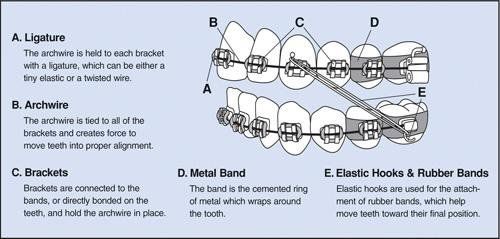

With these tools and supplies on hand in your home (most of which you already have), you will be prepared to handle the most common orthodontic emergencies.
This is not an emergency, but can be a little uncomfortable or embarrassing for the person wearing braces. It is easily fixed with a piece of dental floss. Try tying a small knot in the middle of the floss to help remove the food. Or use an interproximal brush or toothpick to dislodge food caught between teeth and braces.
Tiny rubber bands or small, fine wires, known as ligatures, hold the wire to the bracket. If a rubber or wire ligature is lost, notify the orthodontist, as he may advise whether the patient should be seen.
If a rubber ligature should come off, you may be able to put it back in place using sterile tweezers. If a wire ligature comes loose, simply remove it with sterile tweezers. If the wire ligature is sticking out into the lip but is not loose, it may be bent back down with a Q-tip or pencil eraser to eliminate the irritation.
Of course, when one ligature pops off or breaks, others may follow. Missing or broken ligatures should be brought to the attention of the orthodontist.
Brackets are the parts of braces attached to teeth with a special adhesive. They are generally positioned in the center of each tooth. The bracket can be knocked off if hard or crunchy foods have been eaten or if the mouth is struck while at play. (We encourage all athletes, especially those with braces, to wear a protective mouth guard while playing sports.)
If the bracket is off center, the adhesive may have failed. Call the orthodontist immediately notifying him of the situation, who will determine the course of action.
If the loose bracket has rotated on the wire and is sticking out, and the patient cannot immediately be taken to the orthodontist, you can do a temporary fix to alleviate discomfort and prevent further damage. But take care to prevent swallowing or other injury.
To put the bracket back in place, use sterile tweezers to slide the bracket along the wire until it is between two teeth. Rotate the bracket back to the proper position, then slide it back to the center of the tooth.
If the braces have come loose in any way, you should call the orthodontist to determine the appropriate next steps.
It is normal for a patient to have discomfort for a day or two after braces or retainers are adjusted. But it can make eating uncomfortable. Be assured that the discomfort is both normal and temporary. We encourage soft foods. Rinse the mouth with warm salt water. Over-the-counter pain relievers such as acetaminophen or ibuprofen may be effective.
Some patients are susceptible to episodes of mouth sores. While braces do not cause them, they may be precipitated or exacerbated by an irritation from braces. One or several areas of ulceration of the cheeks, lips or tongue may appear. This is not an emergency, but may be very uncomfortable. Prompt relief may be achieved by applying a small amount of topical anesthetic (such as Orabase or Ora-Gel) directly to the ulcerated surface using a cotton swab. Reapply as needed.
Sometimes new braces can be irritating to the mouth, especially when the patient is eating. A small amount of non-medicinal relief wax makes an excellent buffer between metal and mouth. Simply pinch off a small piece and roll it into a ball the size of a small pea. Flatten the ball and place it completely over the area of the braces causing irritation. This will allow one to eat more comfortably. If the wax is accidentally ingested it’s not a problem. The wax is harmless.
Occasionally the end of a wire will work itself out of place and irritate the patient’s mouth. Use a Q-tip or pencil eraser to push the wire so that it is flat against the tooth. If the wire cannot be moved into a comfortable position, cover it with relief wax. (See Irritation of Cheeks or Lips above for instructions on applying relief wax.) Make the orthodontist aware of the problem.
In a situation where the wire is extremely bothersome and the patient will not be able to see the orthodontist anytime soon, as a last resort, you may clip the wire.
Reduce the possibility of the patient swallowing the snipped piece of wire by using folded tissue or gauze around the area. Use a pair of sharp clippers and snip off the protruding wire. Relief wax may still be necessary to provide comfort to the irritated area.
Jerry L. Sanders, DDS
William P. Tompkins, DDS
Karen A. Green, DDS
Garrett W. Sanders, DDS
Erin A. Sinada, DDS
Courtney S. Smith, DDS
Leah S. Jennings, DMD
Aaron J. Irvin, DDS
Michael D. Crowder, DDS
Jason M. Landers, DDS, MS